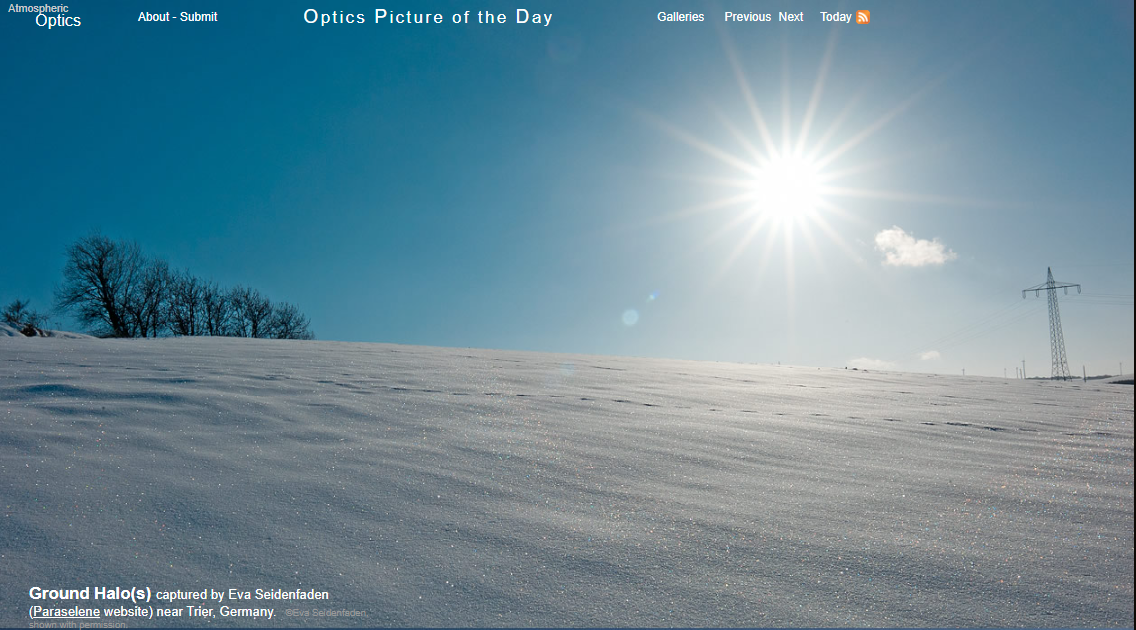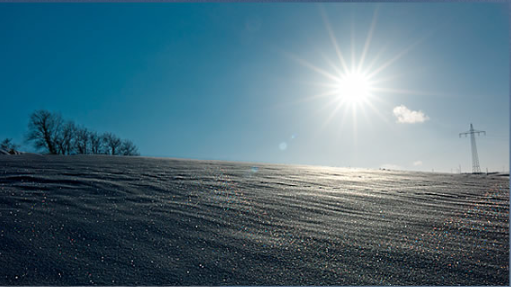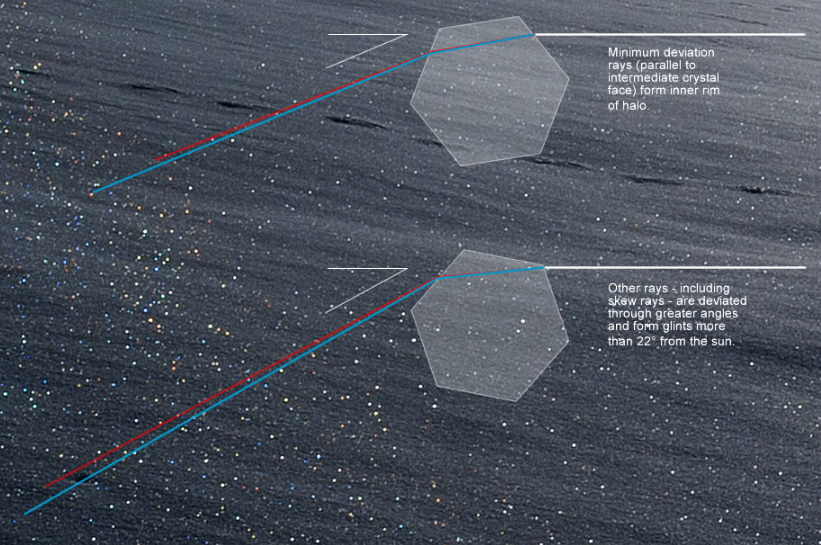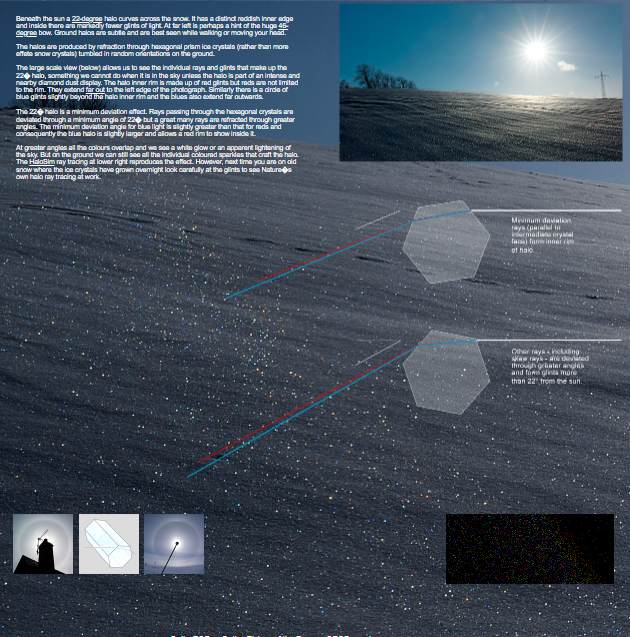OPOD - Ground Halo(s)
OPOD - Ground Halo(s): A Closer Look at Nature's Halo Ray Tracing
Have you ever noticed a subtle and enchanting phenomenon while walking on old snow? Ground halos, also known as ice crystal halos, are captivating optical displays that can be observed near the Earth's surface. These phenomena are best seen while in motion, as they require a change in perspective to fully appreciate their beauty.
Ground halos are produced by the refraction of light through hexagonal prism ice crystals that have fallen to the ground. Unlike the delicate snow crystals that most of us are familiar with, these ice crystals have a more robust structure, allowing them to tumble into random orientations. This randomness is key to creating the intricate patterns and glints of light that make up ground halos.
One of the most common types of ground halos is the 22-degree halo. As the name suggests, this halo forms at an angle of approximately 22 degrees from the Sun. It appears as a circular ring around the Sun, with a distinct reddish inner edge. Inside the halo, there are fewer glints of light compared to its outer region. To catch a glimpse of this awe-inspiring phenomenon, one must pay close attention while walking or move their head to see the halo from different angles.
To truly appreciate the intricate details of a 22-degree halo, we need a large-scale view. In the sky, it is challenging to discern the individual rays and glints that compose the halo. However, when captured in intense and nearby diamond dust displays or on the ground, we can observe these intricate patterns up close. The inner rim of the halo is predominantly composed of red glints, but reds extend far beyond the rim, reaching the edges of our field of view. Similarly, there is a circle of blue glints slightly beyond the inner rim, with blues also extending outwards.
The formation of a 22-degree halo is a result of a phenomenon known as minimum deviation. When light passes through the hexagonal ice crystals, it is refracted at a minimum angle of 22 degrees. However, many rays of light are refracted at greater angles, resulting in the formation of the halo. It is worth noting that the minimum deviation angle for blue light is slightly greater than that for red light. As a result, the blue halo appears slightly larger and encompasses a red rim within it.
At greater angles, all the colors overlap, giving rise to a white glow or a lightening of the sky. However, on the ground, we have the privilege of observing each individual colored sparkle that contributes to the halo's overall appearance. This natural phenomenon can be compared to ray tracing, a technique used in computer graphics to simulate the path of light. Next time you find yourself on old snow with overnight ice crystal growth, take a moment to observe the glints and witness Nature's own halo ray tracing at work.
Ground halos are just one example of the wonders that can be found in our atmosphere. From the delicate beauty of snowflakes to the intricate patterns of ice crystal halos, these phenomena remind us of the complexity and diversity present in nature. So, the next time you venture out into the winter landscape, keep an eye out for these mesmerizing ground halos and let yourself be captivated by their enchanting beauty.

Ground Halo(s) captured by Eva Seidenfaden (Paraselene website) near Trier, Germany. ©Eva Seidenfaden,

Beneath the sun a 22-degree halo curves across the snow. It has a distinct reddish inner edge and inside there are markedly fewer glints of light. At far left is perhaps a hint of the huge 46-degree bow. Ground halos are subtle and are best seen while walking or moving your head.
The halos are produced by refraction through hexagonal prism ice crystals (rather than more effete snow crystals) tumbled in random orientations on the ground.
The large scale view (below) allows us to see the individual rays and glints that make up the 22� halo, something we cannot do when it is in the sky unless the halo is part of an intense and nearby diamond dust display. The halo inner rim is made up of red glints but reds are not limited to the rim. They extend far out to the left edge of the photograph. Similarly there is a circle of blue glints slightly beyond the halo inner rim and the blues also extend far outwards.
The 22� halo is a minimum deviation effect. Rays passing through the hexagonal crystals are deviated through a minimum angle of 22� but a great many rays are refracted through greater angles. The minimum deviation angle for blue light is slightly greater than that for reds and consequently the blue halo is slightly larger and allows a red rim to show inside it.
At greater angles all the colours overlap and we see a white glow or an apparent lightening of the sky. But on the ground we can still see all the individual coloured sparkles that craft the halo. The HaloSim ray tracing at lower right reproduces the effect. However, next time you are on old snow where the ice crystals have grown overnight look carefully at the glints to see Nature�s own halo ray tracing at work.


Note: this article has been automatically converted from the old site and may not appear as intended. You can find the original article here.
Reference Atmospheric Optics
If you use any of the definitions, information, or data presented on Atmospheric Optics, please copy the link or reference below to properly credit us as the reference source. Thank you!
-
<a href="https://atoptics.co.uk/blog/opod-ground-halo-s/">OPOD - Ground Halo(s)</a>
-
"OPOD - Ground Halo(s)". Atmospheric Optics. Accessed on April 19, 2024. https://atoptics.co.uk/blog/opod-ground-halo-s/.
-
"OPOD - Ground Halo(s)". Atmospheric Optics, https://atoptics.co.uk/blog/opod-ground-halo-s/. Accessed 19 April, 2024
-
OPOD - Ground Halo(s). Atmospheric Optics. Retrieved from https://atoptics.co.uk/blog/opod-ground-halo-s/.